Ratings, Grades and Handicaps
The Handicap System
As mentioned in the Introduction to Go, one of the best features of the game of Go is its handicap system. These are placed on the board in lieu of Black's first turn. Once all the handicap stones have been placed in position it is White's turn to play.
Through the grading system, any two players can easily establish the difference in their strength, and therefore how many stones the weaker player should take in order to compensate for this difference. Since a player's grade is measured in terms of stones, the number of stones for the handicap is simply the difference in grade between the two players.
As in other Oriental sports the grades are divided into kyus and dans (equivalent to black belt in Judo), with a novice player starting at about 35 kyu going up in strength to 1 kyu. 1 dan is the next grade above this, with the maximum grade being 9 dan. So a 4 dan player would give 3 stones to a 1 dan player and 7 stones to a 4 kyu player. Professionals have a separate set of grades (also confusingly called dans and with a range of 1-9). A 1 dan professional is about the same level as a 7 dan amateur (typically the highest grade an amateur has) and a 9 dan professional is about the same strength as a 9 dan amateur would be if such a player existed!
If the difference in grades is only one then usually the weaker player just takes the Black stones and doesn't give komi (see below). Typically very few games are played with more than 9 handicap stones, so please ask for advice if the difference in your grades is more than 9. Sometimes extra points (komi) are given instead of extra handicap stones.
Placing Handicap Stones
There is an established pattern for the placement of handicap stones, shown by the dots which are marked on any Go board. This is shown below (Black is facing the board from the bottom), starting with the minimum two stone handicap.
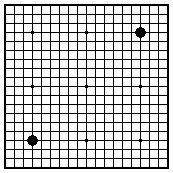 |
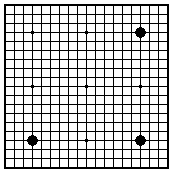 |
|
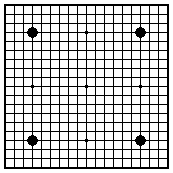 |
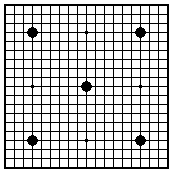 |
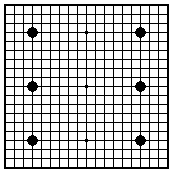 |
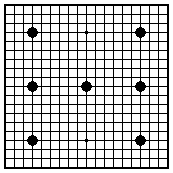 |
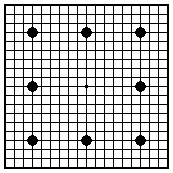 |
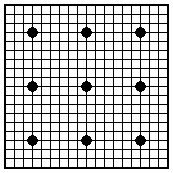 |
Komi
Black has a natural advantage in playing first. So in games between players of the same strength, it is usual to compensate White for the disadvantage of playing second by adding points to White's score. These points are called komi. From experience the value of playing first is about 7 points, so this is the normal size of komi. In tournaments, komi is often set at 7.5 points to avoid draws.
Ratings
For many years grades were adequate to enable people to play to play games which give either player a 50% chance of winning, but in recent years we have wanted to be able to rank people for which purpose the grading system doesn't provide a fine enough gradation. Also, the decision as to when a person was declared to have changed their grade, especially for dan levels when the various National Associations have been awarding certificates (diplomas) was somewhat arbitrary. So a rating system was introduced into Europe in 1996, similar to the one in Chess, which now includes all tournament games played by European players.
For more information about how we manage the UK ratings and grades please see our Ratings and Grades FAQ. You can click on the Ratings link at the top of this page to see the current UK Ratings List.
If you have any comments, please email the webmaster on web-master AT britgo DOT org.
